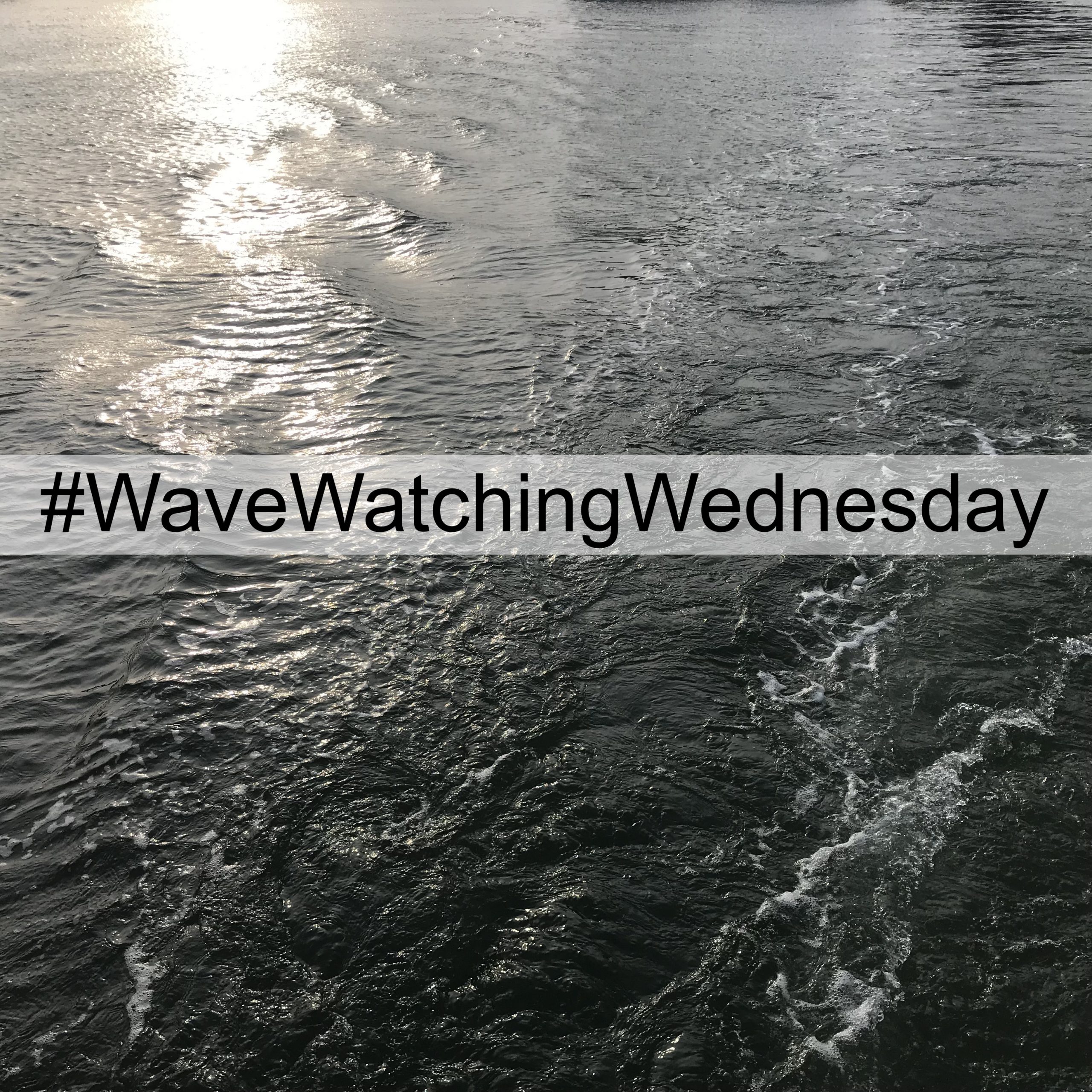
Recap of my #WaveWatching Insta for #WaveWatchingWednesday
Yay! Another recap of my wave watching Insta!
The year started off in the very best company — watching ships and waves and flowers with Astrid!

But of course there is also actual wave watching happening: Here we see a ship’s wake arriving. I find it fascinating how there are the stripes where you can look into the water and then those where you can’t! Total reflection in action. When I learned about that in physics class I never thought that was a phenomenon I would ever see in real life!
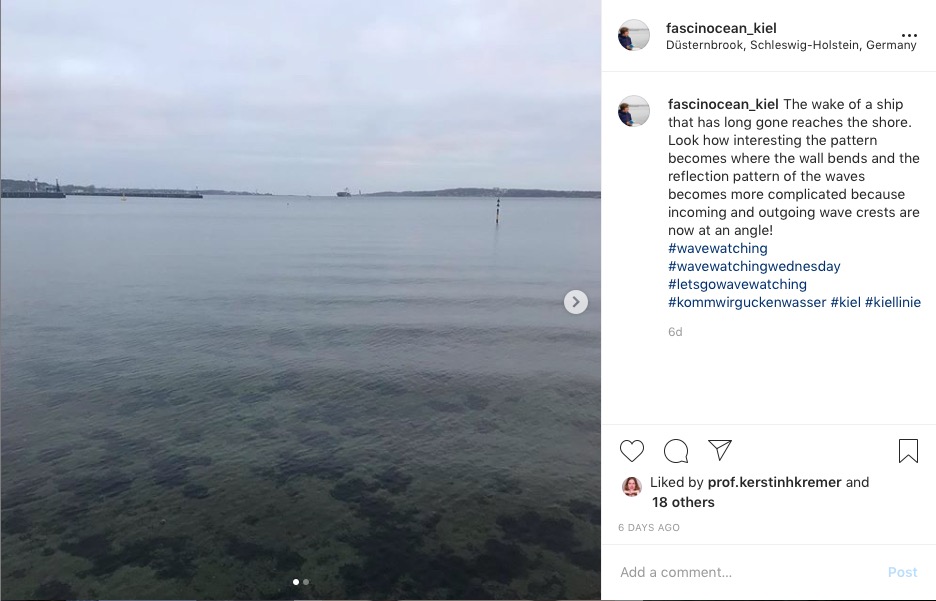
When the waves from the picture above meet the curved sea wall, they get reflected into this pretty pattern.

Another day, foggy and very windy! That day, my focus was on how there are no waves in the lee obstacles. Only after sufficiently long fetch do waves start to grow.

See how the surface roughness changes with distance from the obstacle?

Oh, and then there was a sunny day! The Oslo ferry is leaving in the distance. See the stripes in different blue tones? In the foreground you can see how the colors are related to surface roughness. Areas that are more exposed to wind are rougher with more waves and different wavelengths, and look darker. More sheltered areas in the lee of structures have fewer waves and appear in a lighter blue.

Oh, and then I had a great day with my nephew in the port of Hamburg with harbour boat trips, walks on the beach, and tons of wave watching. He was very impressed by my skill to know how far each wave would run up the beach, especially since we saw lots of people who either ran away screaming or got wet feet :-D

Another picture from the same day with my nephew: Here is a wave train from a ship’s wake arriving at the beach. I love watching this kind of stuff!
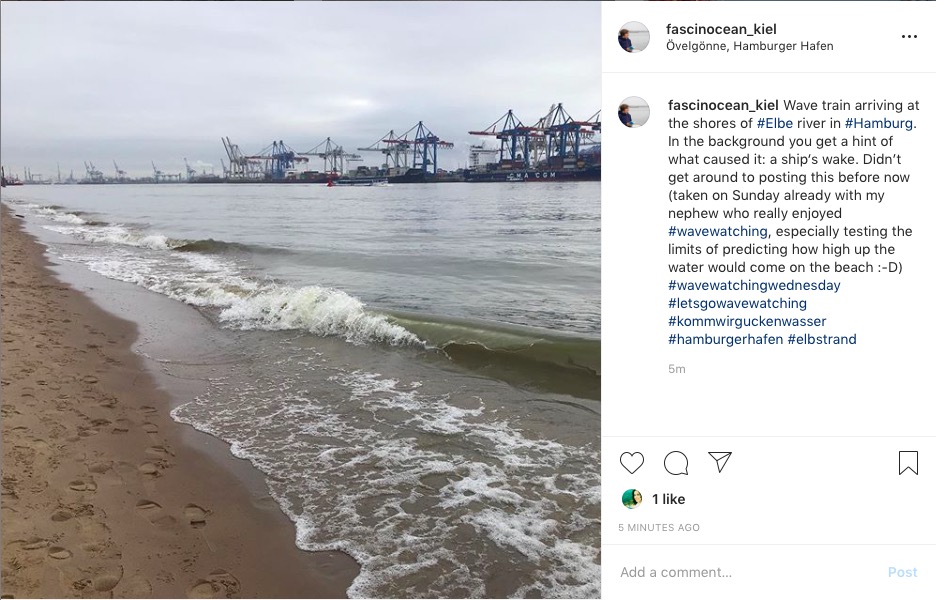
And then one day, I went#WakeWatching! On all three pictures below, you see waves made by the same little ferry. On the right is the turbulent wake where the ship just moved through the water, and on the left some of the feathers that form the V.

Here the ship is turning so we see water that is disturbed by the ship moving through, but doesn’t have the „boiling“ like where the propeller stirred up everything.

Now we see how the wind waves seem to be bunching up at the boundary between the wake and the area that wasn’t affected by the ship moving through.

Then, for #SciCommSunday, I posted a picture of a book that I think is a brilliant introduction to the science of communicating science that I also wrote a blogpost on.

And surprise: Bonus pic for my dear readers that I didn’t post on Instagram but that I think is cool (will definitely experiment with this kind of pictures more! Except panorama mode does weird things to waves, so on second thought maybe not…)

What we are looking at in the picture above is a really low-water day in Kiel. Which leads to interesting wave watching opportunities!
See how waves that arrive with straight crests somewhere offshore get bent as they reach the shallow water? That’s because the velocity of a wave depends on water depth. The deeper the water, the faster the wave can move. The shallower the water, the more the wave is slowed down. Therefore, waves get slowed down first in regions where the water is shallower, and the parts of the wave crest that are still in deeper water wrap around the shallower part. Kinda like when you are slipping on an icy road, you fall in the direction of the foot that didn’t slip because your body spins in that direction.

When there is really low water in Kiel fjord, we can observe the influence of topography on waves much better than we usually can! For example here we see how on one part of the “beach”, there are several wave crests behind each other, all breaking, whereas on the other part on the other side of the headland there is only one wave crest at the water’s edge. Why is that?
Wave crests get steeper and start to break when the water is shallow enough for the wave to “feel” the bottom. On the left side of the picture, depth is increasing faster towards the open ocean: The wave only feels the bottom right before it has reached the water’s edge. On the right side of the picture, on the other hand, the depth changes very gradually. Therefore waves feel the bottom already much earlier and many wave crests are steepening, preparing to break and finally breaking at the same time.
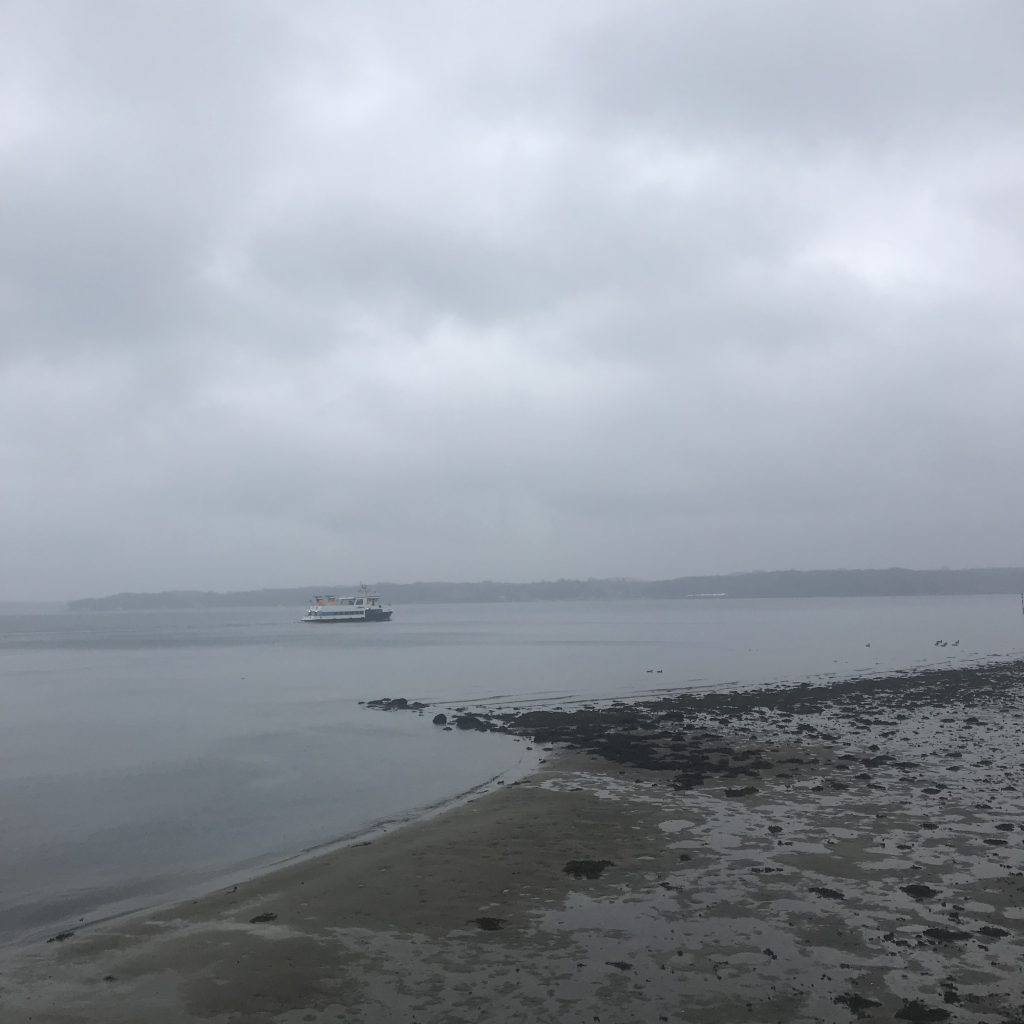
And then I just thought this picture was fun :-)
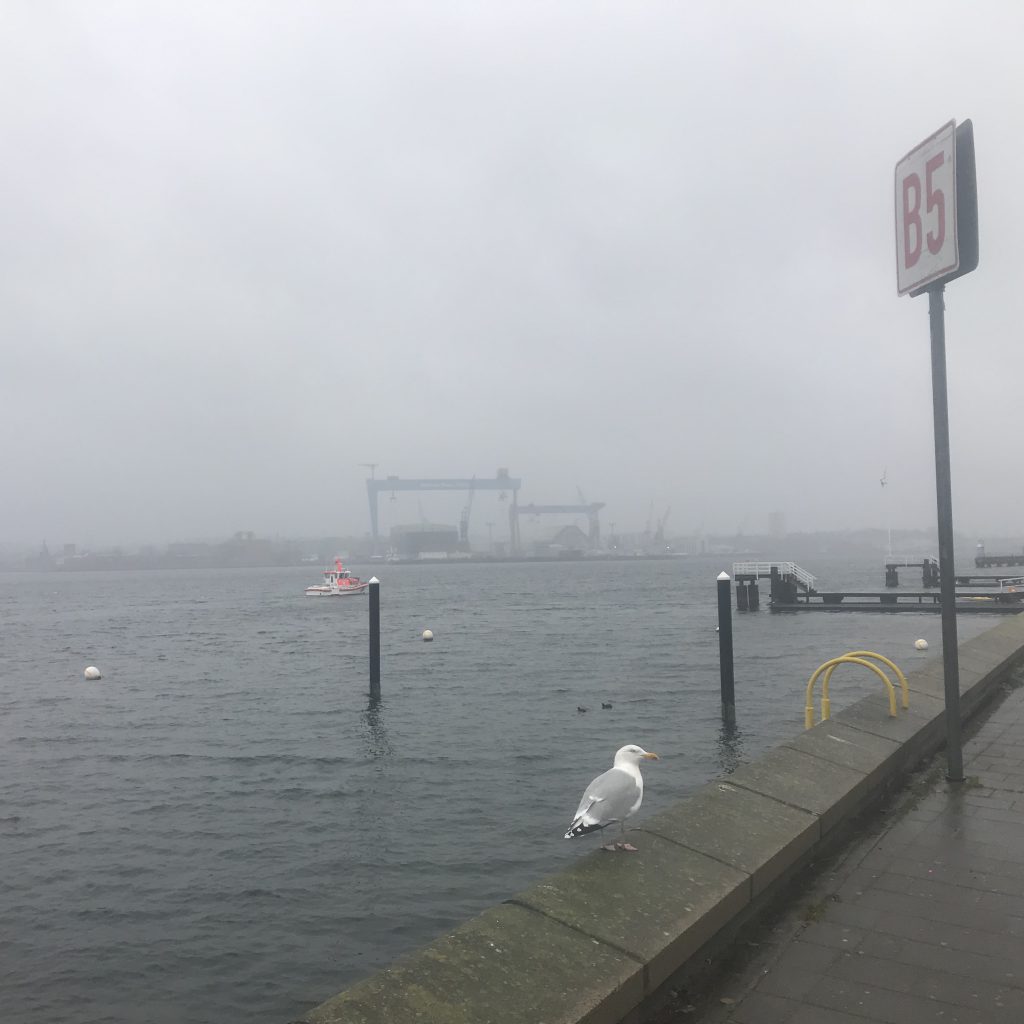
And a rainy day at work!

I actually don’t mind all the rain: It makes the flow in all the storm drains so much more interesting! Here we see how water shoots out of a pipe into a little lake. Note that I’m saying the water is shooting rather than flowing: That means that it is moving so fast that any disturbance is washed away with the water.
As the water shoots into the much slower flowing lake, it pulls water from the sides with it. This water obviously needs to be replaced from further away, so a recirculation is set up.

Here is an annotated version of the picture to see the recirculation going on:

So that’s what has been going on over on my wave watching Insta @fascinocean_kiel! :-)
Joe Buchanan says:
Hi Dr Mirjam.
I love your blog – it is one of the few things I can read on the web without getting wound up. I’ll try to send you some friendly wave photos from Paekakariki, New Zealand sometime.
But for several years I have been bothered by one question – why exactly do waves break? I kayak and bodysurf and have seen thousands of waves breaking, but despite spending some time looking for the answer I have never been satisfied with the explanations offered on surf science websites or by popular science writers (I’ve tried reading technical literature on waves but I usually get stopped by all the equations).
I am afraid you are cheating a bit when you write that waves steepen and break when the wave “feels” the seabed. I know this is a shortcut, but waves don’t feel.
Some writers explain that the lower part of the wave slows down relative to the upper part of the wave, steepening the wave until it breaks. This does make sense but why does this happen? Friction with the seabed is often suggested as a cause but I can’t see how this works. Only the very bottom layer of the wave experiences friction directly. To change the shape of the wave this deceleration would have to be transmitted to the middle part of the wave. I can see how this could happen with a tiny wave, but big waves often look just like small waves only bigger. As far as I know boundary layers in flowing water are usually quite thin – a few centimetres or less. Water further away than this is not being slowed down by friction. And in a large surf the wave often steepens rapidly and breaks in a few seconds. Can drag from the sea bottom really act over several metres in a large wave (like Jaws at Maui, Hawaii or Nazare in Portugal), decelerating tonnes of water to change the waves shape that quickly? And to decelerate the lower part of the wave so much relative to the upper part to form a barrel?
Other explanations talk about the changing shape of the orbital motion of the particles, from circular to oval. This makes intuitive sense as the water shallows, but what force does this? Can breaking waves be explained to someone with a grasp of Newtonian physics, but without the complex math of fluid dynamics? I would be grateful and relieved if can answer this – it does cause me immense frustration.
All the best,
Joe Buchanan
Mirjam says:
Hi Joe,
Thanks so much for your message!
Yep, I am cheating when saying that the waves feel the sea bed. I’ll try to explain my thoughts:
The first thing that is important to realize is that orbital motion of water doesn’t only happen at the surface. From the surface downwards, the orbitals decrease in size until, at a depth of about half the wave length, the water doesn’t move any more (at least not due to the waves. There might still be a current or other stuff going on, but we’ll neglect that). A depth of “half a wavelength” doesn’t sound like much, but with a typical wavelength in swell of up to 700m, this means that the water column is in orbital motion down to a depth of 350m (!!).
As for the oval shape of the orbital motion: Imagine that 700m long wave on a shelf break where the water is suddenly only, say, 200m deep. This would mean that the lower 150m of orbital movement can’t happen any more, just because there is no water there, just sea floor. Since the change in depth happened rapidly, the upper 200m of the water column are still moving. The water at 200m, just above the sea floor, can’t continue to do circular orbital movements, since it can neither go into the sea floor not detach from it. So at the very bottom, the water can only move back and forth, not up and down. It will also move less far horizontally as it would if there was enough water underneath to not inhibit wave movement. Theoretically, water can’t move right at the boundary, but then that boundary where the water doesn’t move any more might also be a couple of mm deep into the sand, with sand being moved back & forth with the waves at the ground.
Now at 190m, water will most likely move mainly back and forth, but might have a small up-and-down component. So this is where the oval shape of the orbital movement comes from. The same thing would also happen if the depth changed gradually, only then it would take a longer time for the signal to propagate through the water column as you point out.
The steepening of the waves happens, because phase speed for shallow water waves (which are per definition waves whose wavelength is more than twice the water depth) depends on water depth as sqrt(gH) with g the acceleration due to gravity and H the water depth. So the smaller the depth becomes, the slower the phase speed of the wave. So as waves move more and more slowly the closer they come to the beach, wave lengths have to decrease since waves that are already closer to land move more slowly than waves that are further out. So the waves further out seem to catch up with the waves closer towards the land. So we have the same amount of water between wave troughs, only the distance between wave troughs gets shorter, which means that the crests have to get higher. As crests get higher, and thus steeper, at some point the whole thing becomes unstable.
Wave breaking often happens where topography changes rapidly, for example on a sandbank or reef off the shore. In those places, the wave doesn’t have time to adjust to the changing depth and form a classical, steady state boundary layer, it basically trips over a step in the seafloor. If the water depth changes very slowly, we don’t get nice breaking waves, it’s a very gradual process because the wave doesn’t get tripped, it just slowly adjusts to the changing depths with the crests veeeery slowly becoming faster than the water underneath it. That’s when we “only” get spilling breakers.
So. I have no idea if that answers your question at all. Please tell me if there are parts in this that were helpful, and on which parts I need to do better!
All the best, Mirjam
Joe Buchanan says:
Thanks Mirjam I am beginning to grasp this. I get the part about waves steepening as they slow down and the troughs bunch up. I can picture waves getting steeper and steeper and becoming unstable – but then I’d expect them to sort of collapse instead of breaking with the tips curling forward.
I think I am unclear about why waves slow down in shallow water. I vaguely remember high school physics teachers comparing this to the medium becoming denser in the case of electromagnetic waves, but I think this was a confusing analogy rather than an explanation.
And I sort of get how a wave would trip over when the depth shallows dramatically (as in a reef break) – if the deeper part of the wave is slowed down first and the top part does not have time to slow down. But what do you mean by a signal propagating upward from the seafloor? Can this effect of slowing down from the bottom upwards be described as a force like deceleration? or is this where waves can’t be explained in terms of newtonian mechanics?
(BTW I was swimming in spilling breakers yesterday, with the waves reflecting off the seawall and a small longshore swell complicating things. Best thing in the world).
Joe Buchanan
Mirjam says:
Hi again Joe! :-)
About the issue with collapsing vs curling forward: I think the eye is easily tricked into believing that the wave is falling forward a lot faster than it is. If you think of large waves that people surf in, then it’s actually quite surprising for how long waves are “almost” breaking, before they start tipping over, then forming barrels, and then eventually fully breaking. They persist in that state for minutes and over distances of hundreds of meters from far offshore towards the beach. And that’s because the very tip of the crest is only a tiiiny little bit faster than the base of the crest, therefore this state of “I’m a little bit ahead of you, but not far enough ahead to actually fall down” persists for such a long time. But in any case, the tip is always a little ahead of the rest of the wave, and it gets further and further ahead over time. Does this make sense?
Why do waves slow down in shallow water? Phew. To me, “friction with the sea floor” seems to explain enough, but clearly that’s not satisfying to you. For me, it makes intuitive sense that in really shallow water, drag would be a lot higher than in really deep water, and that everything in between would be somewhere on that continuum. But I’ll think about it some more.
What I mean by by the signal propagating upwards is that we have a bottom boundary layer that is slowed down by friction with the seafloor. As it is slowed down, it slows down a layer above, and so on. It’s probably all very nonlinear and messy ;-)
Your spilling breakers sound amazing! Snap a pic next time and send me a #friendlywaves! :-)
Best wishes, Mirjam